The winner – Omnisend
Life-changing superhero
In this comparison, Omnisend wins seven out of ten rounds, and three rounds end in a tie. Continue reading and learn how these two platforms compare with each other.
Which Omnisend features are better than Moosend?
- Compatible with SMS, web push notifications, Facebook Custom Audiences and Google Ads
- Provides more marketing automation channels and is easier to navigate
- Free plan with 24/7 email and live chat support, multiple landing pages and automations
- 130+ native integrations with popular ecommerce platforms
- Supports only email marketing
- Automation feature isn't included as a core function, it's a paid add-on
- Offers free plan only for 30 days with limited functionality (only 1 landing page, automation workflow)
- Just about 44 integrations and isn't available on popular tools like Shopify Plus or BigCommerce
Moosend vs Omnisend — which is the better tool for your business?
Moosend has gained popularity over time as one of the most affordable, easy-to-use email marketing tools with an intuitive email editor.
Omnisend is also a powerful email and SMS marketing automation tool. It’s well-known for strong segmentation, automation, and ecommerce integration features. The platform’s interface is intuitive, and it allows you to send SMS and web push campaigns.
This post reviews each tool in detail to help you decide which one best suits your business needs.
Moosend vs Omnisend: Quick overview
Omnisend is arguably one of the best email marketing automation tools for ecommerce stores, with a Shopify App Store rating of 4.8 out of 5, and more than 5,000 five-star reviews. The tool provides affordable pricing plans, powerful automation, excellent customer support, and omnichannel marketing capabilities.
Meanwhile, Moosend introduces themselves as “the simplest and most modern solution to deliver email marketing and automation experiences that drive real revenue growth.” And it’s one of the most affordable email marketing tools.
Both platforms have their own strengths to win your heart. So let the “Moosend vs Omnisend” fight begin.
First, we’ll give you a quick overview of how these tools compare, then we’ll get into a detailed feature-by-feature Moosend vs Omnisend comparison.
Let’s get started.
Omnisend vs Moosend comparison: Feature by feature
Here’s a detailed comparison of both platforms on the most important aspects.
Ease of getting started
Getting started with both tools is pretty straightforward: a few standard questions and no credit card required.
For Omnisend, you’ll need to connect your ecommerce store to make use of all its features.
We tested it by installing it from the Shopify App Store, and it took us a few clicks to connect and get the platform ready to use. The entire setup was a breeze. There are clear steps on how to use the tool and maximize its features.
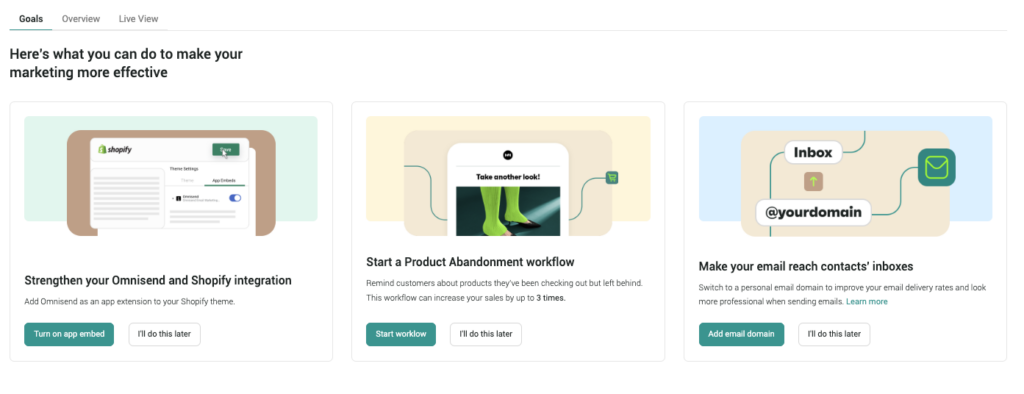
Moosend also has an easy-to-navigate interface and it allows you to connect your online store. However, Moosend doesn’t have a native integration with Shopify. If you are on Shopify, you will need to connect via Zapier. Because of that, connecting your store to Moosend isn’t as seamless as it could be.
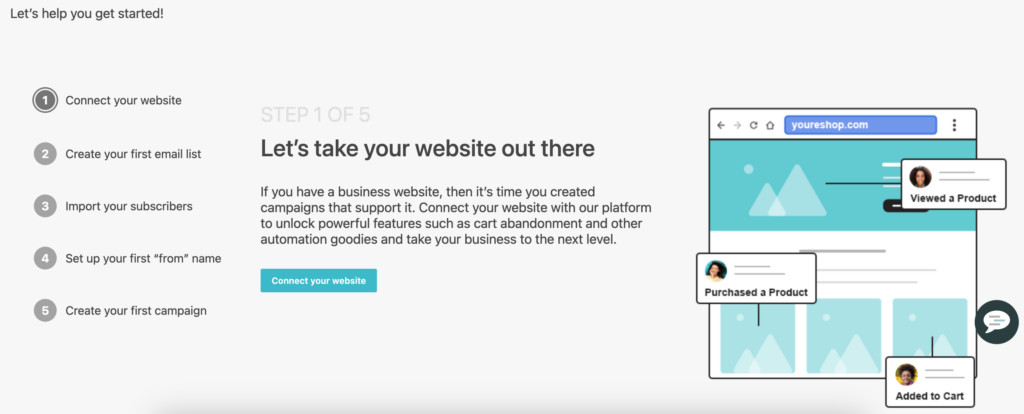
Furthermore, compared to Omnisend, there are a few onboarding items that may not be clear in the beginning. For example:
- Standard categories have unique names. For instance, you’ll find “forms” under the Growth Tools category, automation workflows in the “Recipes”, etc.
- The dashboard design isn’t as aesthetically pleasing as that of Omnisend’s.
- Changing a sender’s email address isn’t straightforward since you’d have to set up your SPF/DKIM first.
Overall, while both tools are quite easy to use, Omnisend takes the lead in this category, with its quick signup process and its clear-cut intuitive interface.
Building an email campaign
Both Omnisend and Moosend have powerful email campaign builders.
They’re easy to navigate, and both give you the option to create multiple types of campaigns, such as A/B testing campaigns and newsletters.
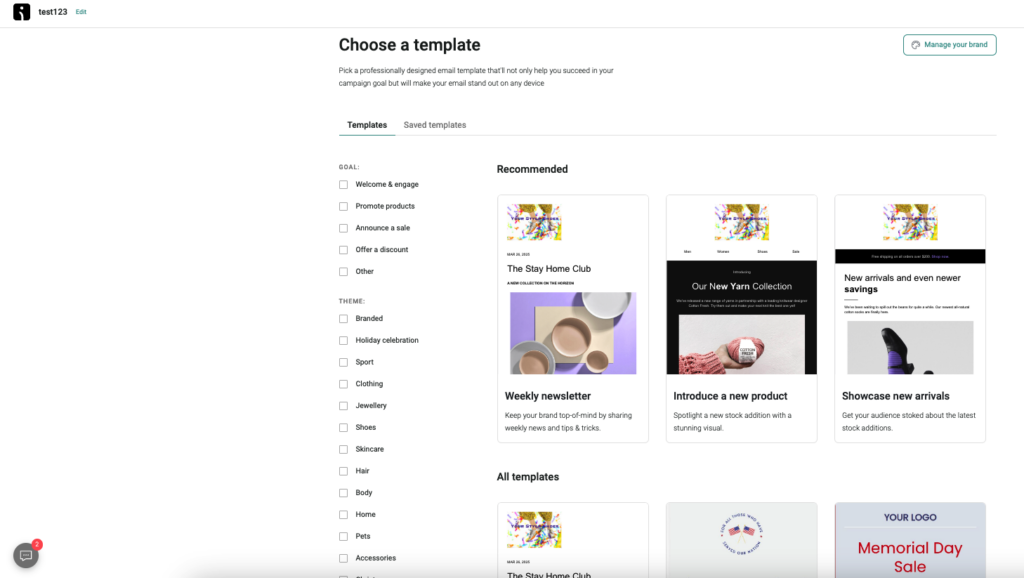
Moosend provides 70+ customizable newsletter templates while Omnisend provides 25. Omnisend’s templates are more modern looking and eye-catching than those of Moosend. However, Moosend lets you add stock images from Unsplash.
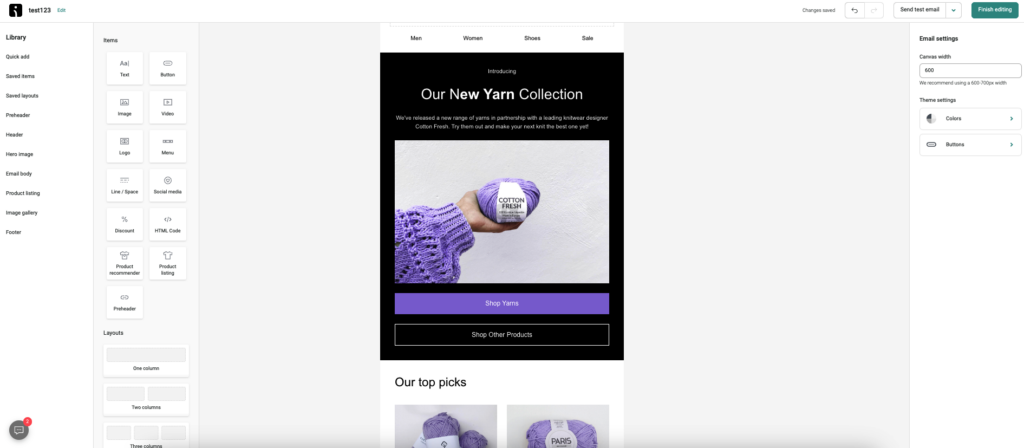
Unlike Moosend, Omnisend’s email editor offers unique features for ecommerce stores. These include:
- Product picker: This lets you add product images and descriptions directly from your store to your emails.
- Unique discount codes: Add discount codes to your emails and offer more personalized offers to your customers.
- Product recommender: Automatically add your top-selling products to your email campaigns to encourage repeat purchases.
Moosend’s email editor also has a few unique features of its own:
- You can add comments on the email editor to give and respond to feedback. This enables collaboration between team members.
- You can zoom in and out of the design section of your editor to resize the editing area.
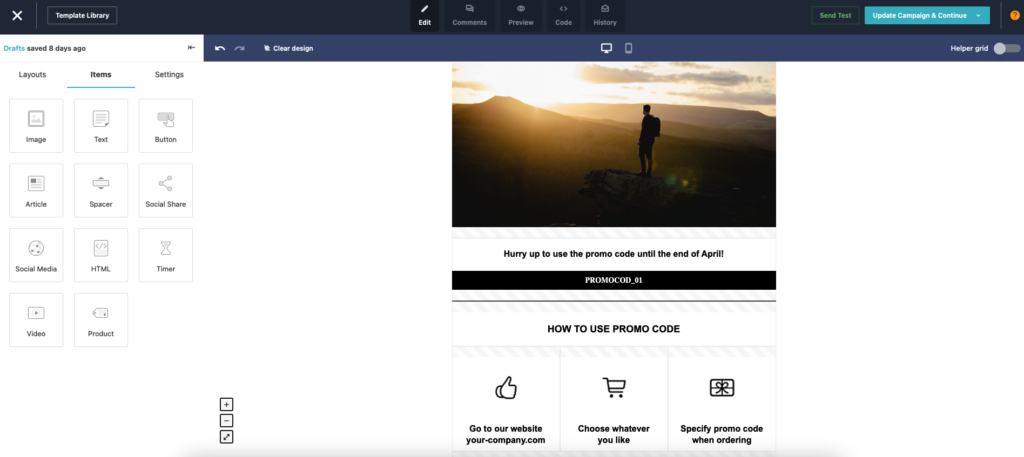
Moosend’s email editor also has lots of useful content blocks like timers and videos. You also get conditional blocks that help you choose which audience segment sees which sections of your emails. This way, you can use a single campaign to target different audiences.
Both email editors are powerful, with powerful content blocks and editing options. Omnisend’s unique features are a plus if you’re an ecommerce business while Moosend’s unique features are best for email marketing teams that collaborate.
Each tool’s uniqueness is great for its target market. So round 2 is a tie.
Marketing automation
Most email marketing tools limit their automation features to higher-tier plans. However, with Omnisend, you can access these features even with the free plan.
Moosend, on the other hand, offers its automation features for the low price of $9 per month.
Which tool offers better marketing automation features?
That depends. Some of Omnisend’s popular automations include:
- Welcome email series
- Product abandonment workflows
- Browse abandonment workflow
- Cart abandonment email series
- Order and shipping confirmation workflows
- Birthdays
Omnisend provides multiple triggers to set off these workflows. It also offers A/B testing to compare their performances. And these are all available in the free plan.
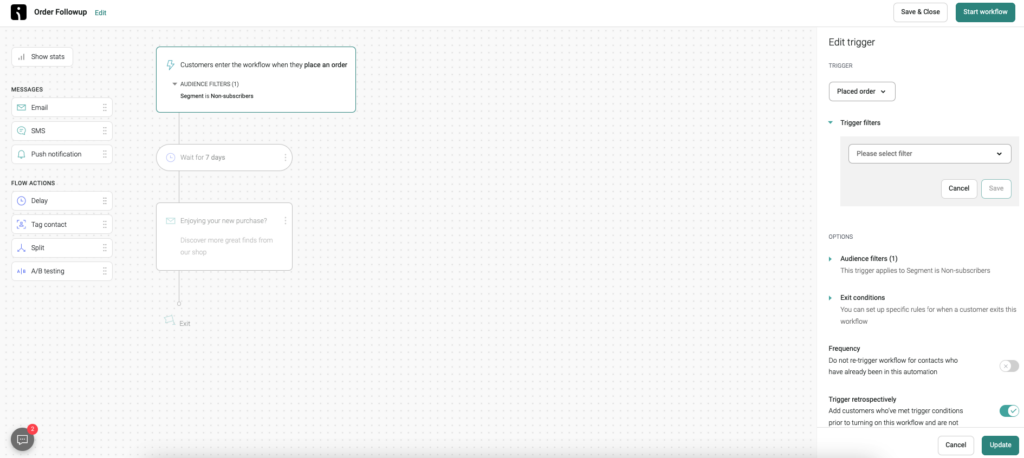
What’s more?
The tool lets you include SMS and web push notifications into these email automation workflows to be able to reach customers through different channels. This option isn’t available with Moosend.
Moosend’s automation options are relatively robust, and you’ll get a set of triggers and filters to make your campaigns more targeted. However, they’re not as advanced as Omnisend’s.
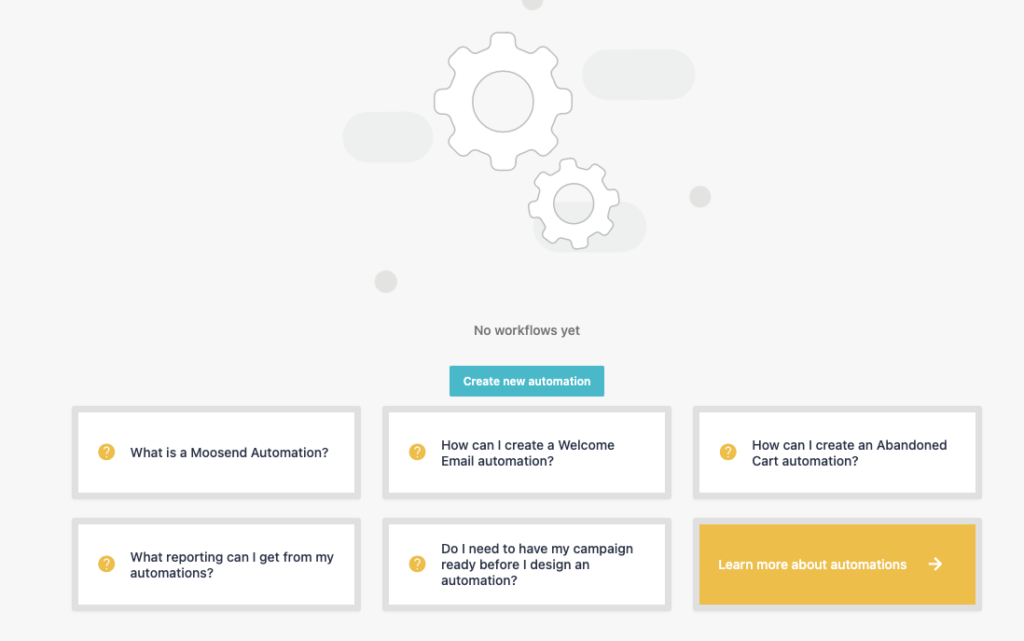
For instance, Moosend provides up to 18 prebuilt marketing automation templates. Like most email marketing tools, these templates only contain the logical flow. You’d have to add the content yourself.
Unlike Moosend, Omnisend provides 25 prebuilt automation workflows, complete with the rules and content. These are ready to go and can be used straight away. Some only contain emails while others include text messages as well.
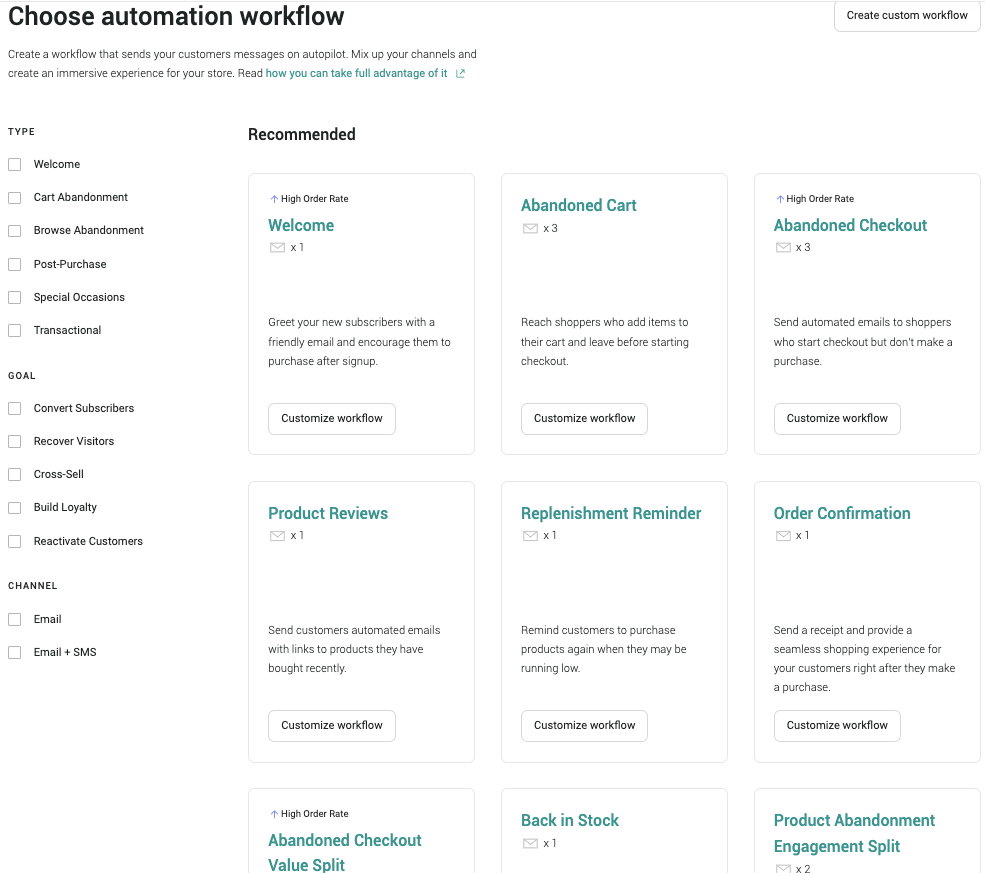
Omnisend’s automation tool is also straightforward and easier to navigate compared to Moosend’s.
Omnisend wins this round for being more robust and providing more channels.
Signup forms and landing pages
Both tools offer a wide variety of signup forms and landing pages. And the best part? Most of them work right out of the box.
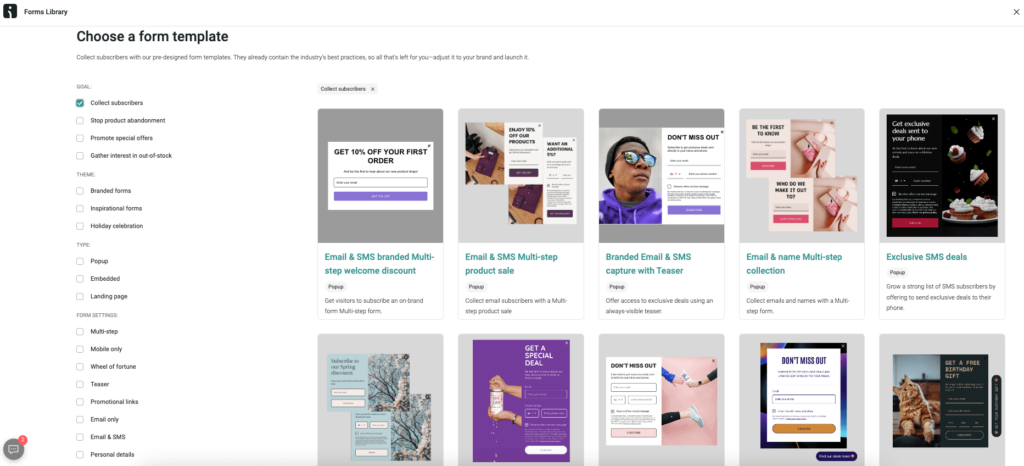
On Omnisend, there are over 80 signup form templates for building your email list. These include popups, teasers, landing pages, and the Wheel of Fortune (a gamified popup that lets customers spin the wheel to win a discount). All templates are design- and copy-ready, meaning you can launch them immediately.
They both also offer customizable landing pages. Omnisend, in particular, has loads of landing page templates that you can launch out of the box or use as inspiration.
Unlike Moosend, you can add your brand image and colors with Omnisend, and the tool will automatically adjust all your landing pages and forms to fit your brand.

Meanwhile, Moosend provides a wider variety of subscription forms, although they are more limited.
Forms available on Moosend include:
- Modal and promotion popups
- Inline forms
- Floating bar and boxes
- Full-page subscription forms
Clearly, Omnisend has the upper hand as it offers better designs, occasion-ready options, and greater flexibility when editing the forms.
And what about analytics?
Both tools provide you with signup form analytics, letting you track how each is performing. This way, you’ll know which of your lead-capturing efforts are the most successful.
Speaking of list management, both tools let you import your lists from files or other platforms and map them easily.
With Moosend, you can do so manually or through its integration with Salesforce.
And on Omnisend, you can add your new contact list manually, import files, or use their Mailchimp and Klaviyo direct import tools that allow you to simply switch the email service provider.
You can also tag your audiences based on multiple criteria and the tool provides various examples to get you started. Additionally, there are no duplicate contacts with Omnisend, and you can get a list-cleaning service for an extra cost.
Omnisend wins here as it has more to offer in terms of lead capturing and list management.
Segmentation
Omnisend has a robust functionality that lets you segment your email lists based on certain criteria. Whether you’re looking for basic segmentation or you want to target specific relevant audiences, the tool provides excellent segmentation capabilities. Here you will find conditional splits, multiple filters, and tags.
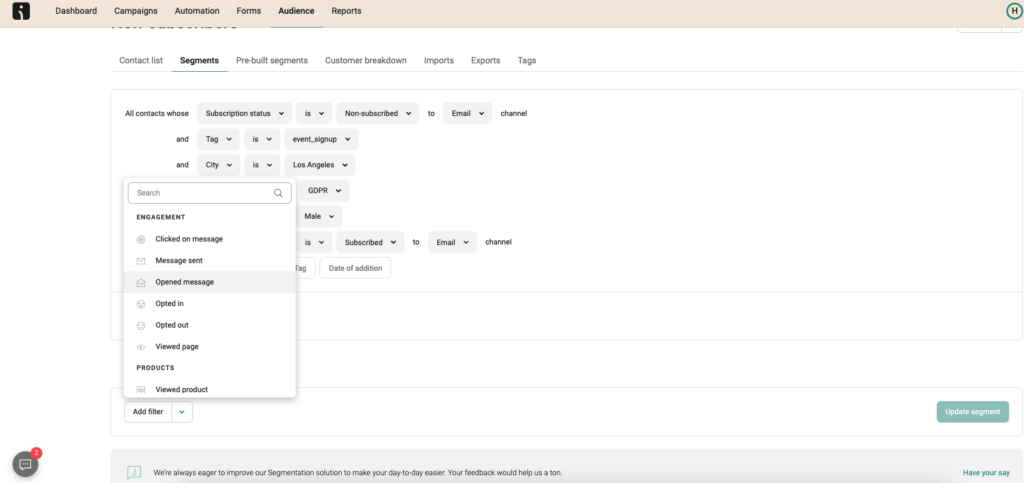
Omnisend also offers 23 ready-to-go pre-built segments that you can implement as is, including:
- High potential buyers
- Received a voucher but didn’t use
- Most engaged email subscribers
- First-time buyers
- Clicked on promotional messages
- Lapsed email subscribers
- Bought an item after clicking on a campaign, etc.
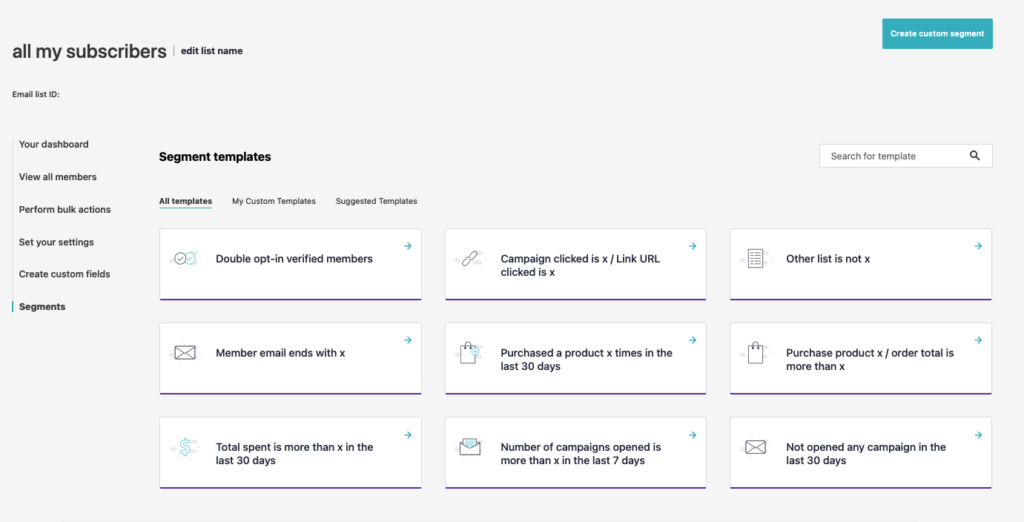
Moosend’s segmentation capabilities are decent too. They’re based on criteria such as
- Email campaign engagement
- Purchasing behavior
- Amounts spent
- Demographics
- Website activity, etc.
Moosend also offers nine ready-to-use segments. That’s not as many as Omnisend, but still can be a great place to start.
Both Moosend and Omnisend have a decent customer segmentation feature set. So in this round, it’s a tie.
Analytics
Speaking of analytics and reports that you can get on these two platforms, we must say that both platforms have their pros and cons.
Omnisend provides sufficient reports to help track your ecommerce marketing performance. These include:
- Click maps: These reports track how your customer interacts with your links and CTAs within the email campaign. By tracking these, you can know where to place CTAs most effectively, which links had more clicks, and overall, which campaigns were more effective.
- Engagement rates: This includes your audience’s interaction with your emails and is measured in terms of open rates and click rates.
- Revenue reports: These show you where your sales come from, which campaign or which marketing channels are most effective, and so on.
- Advanced reporting: You can see automation workflows with highest open rates, campaigns with most total revenue, segments performance, etc. This kind of reporting is available only for Pro plan users.
While Omnisend provides all the insights you need to scale your ecommerce store, it doesn’t have some of the most basic reports, such as geolocation reports.
Meanwhile Moosend, provides the vast majority of standard reports: campaign engagement, unsubscribes, heatmap, locations, etc. You may also set up customer reports on your campaigns, mailing lists, web analytics, etc. If you connect Moosend to your store, you can definitely get many good insights.
Moosend lets you create custom reports so each team or project can pull only the relevant statistics. One thing worth noting is that custom reports are limited to 10 widgets and available on the Enterprise plan only.
While Omnisend lacks some basic reports, it provides more in-depth ecommerce insights. Moosend, on the other hand, provides more basic reports but lacks some predictive, in-depth metrics. So in this round again, it’s a tie.
Customer support
Both platforms lack phone support.
Omnisend offers more resources than Moosend does. It also has numerous positive ratings on sites like G2 and Capterra for excellent customer support. Not to mention being a two-time Stevie Awards winner for best customer service in 2022 and 2023.
Omnisend wins this round, hands down.
Integrations
Omnisend integrates seamlessly with ecommerce platforms like Shopify, BigCommerce, and WooCommerce. Omnisend’s reviews on these platforms are outstanding.
This platform is also a Shopify Plus Certified App and a BigCommerce Elite Partner. So if you own an ecommerce store, Omisend should be at the top of your list when considering email marketing automation solutions.
Other than that, Omnisend has over 130 other integrations, including:
- Shipping and logistics apps like Shipstation and AfterShip
- Customer review integrations with Yotpo Product reviews and more
- Social media retargeting integrations with Facebook
- Zapier to connect to all your other tools
- Loyalty and rewards apps like Loyalty Lion
Moosend’s integrations with ecommerce platforms are limited. For instance, the tool isn’t available on Shopify Plus or BigCommerce, unlike Omnisend and other popular email marketing tools.
Moosend has about 44 native integrations with other tools, such as WooCommerce, Magento, Zapier, Salesforce, Involve.me, and Poptin. The rest of the integrations you can get through Zapier.
Omnisend carries the day for round 8 as it offers more native integrations with ecommerce platforms, and has more integrations for marketing, in general.
Compatibility with other channels
Moosend only supports email marketing and offers no other marketing channel. The only thing that comes close is the ability to add a Facebook pixel to your landing page.
Omnisend, on the other hand, is compatible with multiple channels:
- SMS: Omnisend lets you communicate with your customers globally through SMS. You can also combine automated text messages with your email campaigns and sync them into a single workflow for maximum impact.
- Web push notifications: You can add push notifications to your automated workflows to instantly retarget your store visitors. These include cart abandonment, browse abandonment, and transactional notifications. You can add these to your email or SMS campaigns or both.
- Facebook Custom Audiences: This feature helps you retarget your customers through Facebook and Instagram ads. Omnisend provides this service on autopilot by syncing your contacts directly with Facebook based on their shopping behavior.
- Google Ads: This feature helps you retarget prospects who visit your website with relevant Google ads. This saves you the trouble of sending cold campaigns to audiences that may not be interested in your brand.
If you’re looking for omnichannel marketing to optimize your email campaigns and boost ecommerce revenue, you definitely want to go with Omnisend.
Omnisend is the winner.
Price comparison
Which software is more affordable, Omnisend or Moosend?
Moosend offers two types of pricing plans. One is the tiered monthly plan and the other is the pay-as-you-go credit based-plans. Each of these sets of plans offers specific features. We’ll discuss these later.
Unlike Omnisend, Moosend doesn’t have a freemium plan. All they have is a 30-day trial with limited features.
This is great for when you want to try out the tool before committing financially.
Omnisend’s free plan comes with most of its advanced features. This makes it not only suitable for testing out the tool, but also for use by scaling businesses on a budget.
Overview of the free plan features
- Unlimited emails
- Email and chat support
- 1 landing page and 1 signup form
- 1 automation workflow
- Basic reporting and analytics
- Basic templates
- Up to 250 contacts, 500 monthly emails, 60 SMS, and 500 web push
- 24/7 email and live chat support
- Popups and landing pages
- Pre-built automation workflows
- Sales and performance report
- Professional-looking email templates
You could say that Moosend is cheaper than Omnisend since you can get automated workflows and other features for only $9.
But is that true?
Well, considering how much more you get from Omnisend—advanced segmentation, powerful integrations, and omnichannel marketing—$16 is a good deal.
Moosend has a mobile app available to help you monitor your email marketing activities on the go.
The pay-as-you-go plans by Moosend are advantageous for businesses looking for more flexibility. The plans start at $350, which means that they may not be suitable for small businesses.
Here are the credit payment options:
- $350: 350,000 email credits
- $500: 500,000 email credits
- $750: 750,000 email credits
- $1,000: 1,000,000 email credits
With the above plans you get similar features to those available with Moosend’s Pro plan. These include more marketing automation workflows, transactional emails, landing pages, and custom reporting.
Overall, both tools are affordable based on the features you get for each pricing plan. Omnisend offers more and is, therefore, priced a little higher. It also has a free plan, something that Moosend doesn’t provide.
Beyond that, Moosend’s pay-as-you-go plans are pretty expensive.
Summary: which one wins?
4.8
3.8
Free plan- Yes
500 subscribers- $16
1,000 subscribers – $20
5,000 subscribers – $65
10,000 subscribers – $125
50,000 subscribers – $330
100,000 subscribers – $720
Free plan- No
500 subscribers- $9
1,000 subscribers – $16
5,000 subscribers – $48
10,000 subscribers – $88
50,000 subscribers – $315
100,000 subscribers – $624
- Reach up to 250 contacts
- 500 emails/month
- Up to 60 SMS and 500 web push
- Automation workflows
- Unlimited segmentation
- Landing pages and signup forms
- Unique email templates
- 24/7 customer support
- No free plan, but you’ll get a 30-day free trial with access to most features
- Modern-looking signup forms
- Uniques newsletter templates
- Advanced analytics
- Robust automation and segmentation
- Seamless ecommerce integration
- Unlimited email sends
- Great segmentation and automation
- Intuitive email editor
- Pay-as-you go pricing option
- More expensive than generic email marketing tools
- No geolocation reporting
- No free plan
- No native Shopify integration
- No other marketing channels provided
- Some outdated email templates
- All ecommerce stores
- Beginner and advanced marketing user
- Ecommerce beginners
- Non-profit organizations
- Solopreneurs
- Bloggers
- Governmental and non-governmental organizations
- Fast scaling ecommerce businesses
Moosend is an easy-to-use email marketing tool for businesses looking for automation features for a lower price. The reporting feature is also one you can’t overlook.
Omnisend is a specialized ecommerce marketing tool built with online store owners in mind. The tool excels at providing ecommerce businesses with robust marketing features.
Besides having native integrations with top ecommerce platforms, Omnisend provides specialized features like a product picker, product recommender, web push notifications, and SMS marketing.
Moosend has fewer ecommerce features, but if you don’t need them, it can be your bet as it’s more affordable. However, for ecommerce stores serious about growing their business, Omnisend is a better choice.
You may also want to check Omnisend vs Constant Contact and Mailchimp vs Moosend articles.
Read full reviews
Our team strives to be accurate and unbiased in reviewing email tools. However, we recognize that mistakes can happen, and it’s essential for us to stay up to date. If you come across any errors or things that need to be reviewed again, please let us know.





Leave a Reply